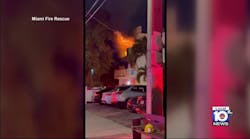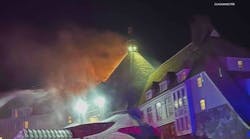This article covers some of the key radio transmissions that an engine company officer should make, to help other companies make decisions on the fireground.
In the fire service today, we are better equipped and better trained than ever before. But we are still missing one thing when it comes to the fire ground -- effective communications!
Communicating on the fire ground allows us to coordinate the fire attack so everyone is working together. While the lack of communications today usually doesn't cause any trouble, every once in a while it manages to kill one of us.
I always read the close calls and NIOSH reports with this in mind. Not that I was at the fire and not that I'm an expert, but I just relate it to experiences that I've had in my time in the fire service.
These reports often lead me to look at the communications of the operation and how it affected the decision-making of command. What was reported on the fire ground/tactical radio channel and what was held back because it seemed unimportant? The smallest thing in one part of the structure can be a disaster waiting to happen in another.
On the fire ground, every thing that we do affects others on the scene. Not venting correctly may affect the ability of trapped persons to live long enough to be rescued. Not announcing that the building is starting to fall apart can affect every one inside the zone. Basically, it all counts somewhere on the scene.
For me, radio communications are the life-blood of the decision-making process for command. The old saying "we can only make decisions based on what we know at the time" applies directly to the incident command (IC) position. And because of our heavy reliance on the incident command system, the chief of operations must have current information to decide if an interior attack should continue or be moved to a defensive position.
So, are there critical radio reports that the chief must have to make good decisions about the operation? We're talking about radio reports that firefighter lives depend on here. I say there are, and they come from the engine officer on the scene.
The engine is the core of any fire solution. If we put out the fire, the problem goes away. On the standard fire, if there is such an animal, the engine officer provides a number of reports that makes the ICs decisions easier. The commander should be listening for these communications during the incident, and if they are not transmitted they should be requested. The sooner information is received the more useful it is.
At the start of the incident, the engine company is likely to be the first unit on the scene. When this happens, the officer should provide a good, first-due radio report that in-coming companies will hear. Describing the conditions is an art. The pressure is on to quickly understand the event. and report it so everyone knows what to expect. This radio report must be clear and concise so it sets the stage for the rest of the operation.
It should also contain common terms that will be understood by everyone. This radio report can be pre-planned to a large extent so department members know what common terms to use. Here's a suggestion on what to include:
- The apparatus type and the number (Engine 123, Truck 39)
- Confirmation of the address
- The engine's placement in comparison to the building (this is important if the position of the unit determines in what manner the department will secure a positive source of water)
- The fire conditions and the construction of the building
- Any other specific needs for the first due unit (like extra alarms)
A good example of a report would be the following: "Engine 123 is on the scene at 2215 West 15th Street. We are westbound on a 2 1/2-story balloon-frame residence with fire on the first and second floor. Give me a second alarm response."
This transmission fills in many of the blanks for command on what has been found and what additional help is needed.
Sometimes, when firefighters first arrive to an incident, the location and extent of the fire remains unknown. So it can't be reported in the first unit's transmission. This can happen when smoke is only showing and a "read" on the building does not necessarily pinpoint the seat of the fire. It can also happen when the building is so large that it hides the fire inside or smoke is blowing directly into the faces of the firefighters.
One threat to scene safety is to allow an operation to gain steam without everyone having a clear understanding where the fire is. Ventilation can draw the fire to uninvolved areas. For these reasons, when the engine officer confirms the location of the fire and orders the hose line stretched, they should report the action to command so every firefighter on the scene can hear it.
An additional report from the engine officer should be on the progress of the hose advance. Once it has started, how is it going? Will the water to the seat be delayed? There are many things that can slow or stop the extinguishment. A few things that come to mind immediately are inadequate ventilation, loss of water due to a broken hose length and the inability to advance to the seat effectively due to pack-rat conditions inside the building. All of these troubles should be reported to the IC as soon as possible.
An additional problem exists when the nozzle reaches the seat of the fire. What if the fire won't go out at all? When the water starts to flow, the officer should monitor the stream's effectiveness. Is it working to extinguish the fire or not? Even if we haven't had a fire since our original, academy training, we should compare the nozzle's effectiveness against a successful knock.
If the fire isn't going out in short time, why? Is the room larger than was originally thought because we are in a building with an unfamiliar floor plan? An example would be a commercial structure. Maybe the room is so large we are not making the critical flow needed to extinguish the fire. It could also be possible that the fire is being fed by some flammable liquid or gas?
In a residential setting, when there is no quick knock a question to ask is: has the fire been vented into a strong wind which is now feeding it? Will a second hose be enough to complete the task? The IC will need to decide if a second hose team is even available after receiving the engine officer's radio report.
Will the first engine need to back out before a backup line is put into service? Again, the engine officer should consider this and report to the IC if conditions don't get better. The firefighters in other parts of the structure who are affected by the loss of water will need to know what is happening.
Effective communications on the fire ground are important to coordinate the actions taken by firefighters working in and around the structure. The engine officer's words to the IC are critical because as the first hose line goes, so goes the entire operation.
JIM MASON has over 20 years in the fire service and serves as a lieutenant with the Chicago Fire Department. As a firefighter he has been assigned to engines, trucks and heavy rescue squads. He is a lecturer on fireground operations and is currently serving on a International Association of Fire Fighters committee to help develop a firefighter self-survival program.





